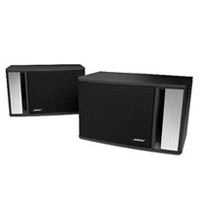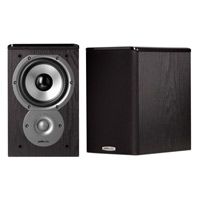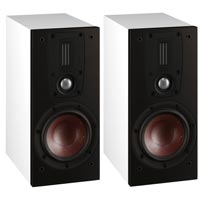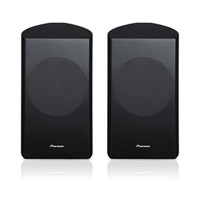The Best Bookshelf Speakers - How to Decide?
Deciding which are the best bookshelf speakers isn't easy. So much depends on your individual needs, how much space you have, and of course how much you want to spend!
Like a lot of audio components, there's not much difference in sound quality at the very bottom end of the market. At entry-level prices, it's more about how the thing looks!
But once you get above about $100, subtle differences in sound quality start to creep in. By the time you're getting to the $500 level, personal preference starts to become a significant factor.
There's a huge choice of bookshelf speakers - it can be hard to know where to start. I can make one recommendation right here and now - in my opinion, all the speakers under $100 sound about the same. So I'm going to concentrate on 7 models that I think are candidates for the title "Best Bookshelf Speakers", in the price range $150 to $750.
Without further ado, here we go!
The Top 7 Best Bookshelf Speakers
Bose 141. These are very small speakers that take up very little space.

They have a single speaker cone in each cabinet, and therefore do not need a crossover to split the high frequency signals from the low frequency ones. This is therefore a very simple design which benefits the sound you get for your dollar!
The speaker cone is based on Bose' well-known 4 1/2" unit from the famed 901, and is capable of taking a lot of power for its size. In fact, the Bose 141's can handle anything from 10W per channel up to 80W per channel!
The simple design can deliver astonishing volume from such a small cabinet size, but of course it cannot generate deep bass nor top-end crystalline clarity on violin or piano notes (for example). It's ideal for smaller rooms such as a den, a dormitory or college room.
Yamaha NS 333. This is a significant step up from the Bose 141 in terms of size and performance.
The Yamaha NS333 has a bigger enclosure and 2 drivers: a 1 inch aluminium dome tweeter and a 5 inch polymer bass cone.
The enclosure itself has a smart-looking piano-black finish, and the whole package just smells of quality. These bookshelf speakers use heavyweight internal wiring from Monster, and a good quality crossover.
The sound quality is more "open" than the Bose 141, with the 2 drivers being able to cope with deeper bass and higher top-end notes. Of course, such a small speaker is still unable to generate that "punch in the stomach" bass that big floor-standing speakers are capable of, but it's more than enough for smaller rooms.
Overall volume levels are about the same as the Bose, although the Yamaha NS333 doesn't need quite as much power from your amplifier to get there. A good choice if you have a bit more space available, and like a slightly brighter sound. Definitely one of the best bookshelf speakers in the lower price range.
Polk Audio TSi 100 at around $200. At the same price point as the Yamaha NS333, the Polk TSi 100 uses some clever tricks to simulate the sound of a bigger speaker.

First of all, the Polk Audio units are well-finished, look well-put together, and have a reassuring weight to them. Like the Yamahas above, they have 2 driver units, but use a silk dome tweeter and a polycarbonate bass driver. Polk states on its website that they feel aluminum dome tweeters can sound harsh.
The TSi 100 uses some electronics which effectively reduces the impedance of the speakers at low frequencies. This makes the bass driver more efficient, and results in a slightly louder bass than would otherwise be the case.
Polk claims that it's like having a 30% bigger cabinet. The cabinet also has a bass port exiting at the back, another trick to boost bass output slightly.
With its sturdy construction and bag of electronic tricks, the TSi 100 has a wider sound spectrum than the speakers mentioned so far. It needs at least 20W per channel to drive it adequately, and can cope with amplifiers up to 100W output. Definitely worth considering!
Klipsch Synergy B 20 at around $250. Although the B20 doesn't boast the bass response figures of the Polk TSi 100 on paper, it actually sounds like it has a better bass. This is thanks to a 5 1/4" bass driver with a reflex port.
It's not a heavy nor plodding sound, just solid and clear, although it does fall off lower down the register compared to floor-standing speakers. Klipsch have a sub-woofer in the Synergy range, intended to compliment the B20s in a Home Theater set-up.
Interestingly, Klipsch prefer to use an aluminium dome tweeter with horn loading for the top end. As you may know, Paul Klipsch is a champion of horn loaded speakers, and he makes it work well even in this small bookshelf design.
The 2 drivers seem well-matched, and are quite efficient, providing a wide sound stage and room-filling volume without needing much amplifier power.
I like the authority of the B20s. The sound quality is getting into "good standard speaker" territory. This is a great choice if you have a small room that is bigger than the standard study or den. Good for Wagner and Beethoven fans!
Dali Ikon 1 MK2. The Danish speaker manufacturer "Danish Audiophile Loudspeaker Industries" (DALI) is well known.

Their Ikon 1 has an unusual design that has TWO high-frequency drivers, a conventional soft dome tweeter AND a ribbon tweeter. This seems to give a very clear and transparent mid-range and treble. Violin notes sound accurate and sweet, while solo classical piano pieces shimmer.
The bass driver is a wood fiber unit with two small reflex ports facing forwards. The bass sound extends down quite well, but is "lightweight", without the thumping authority of the Klipsch B20. Some people may say that the DALI is more accurate - this is where you have to listen for yourself and decide!
The Ikon 1 is not particularly efficient, and needs a bit more power from your amplifier to get up to a decent volume, but can cope with up to 100W per channel.
I think the DALI is more suited to music such as string quartets, solo instruments, and pieces from Schubert and Delius.
There's no doubt that the Ikon cabinet is beautifully made, and it is quite slim, making it look elegant as well. It's just as well - they sell for over $500!
Pioneer S 71b Around $750. These speakers feature yet another design! They have a titanium dome tweeter positioned in the center of the aramide bass woofer.

This dual-concentric driver arrangement also has a reflex port facing forwards to enhance the bass response.
Pioneer claim that this arrangement results in a more realistic "point source" effect, giving a broad sound stage and life-like 3-dimensional positioning of instruments and voices.
The sound of the Pioneers is a little different from everything else listed so far. At first it seems a little lacking in weight, but then you realize that all the notes are there, but with a subtle accuracy that can be deceiving. Instruments in an orchestra are well located in space, and there is a real dynamism to the music.
The cabinets are quite plain, and the sides are curved around towards the rear, giving an understated appearance. You'll need a bit more amplifier muscle to drive the S 71b, as they can deal with up to 130W per channel.
They're also pretty much physically the biggest of the bookshelf speakers listed so far. You'll be able to fill a fair-sized room with quite a lot of music at high volume!
Finally, the JBL L830, which is listed at $750, but available from Amazon for closer to around $400. Although JBL call them "bookshelf" speakers, they are rather large, and probably too deep from front-to-back to fit neatly on any bookshelves!
They are also heavy, at over 20lbs each. Really, they are better considered as needing stand-mounting, but I wanted to include them here because I think they are so good.
The L830s have 3 drivers:
- a Mylar ultra high-frequency dome
- a 1" titanium dome tweeter
- and a big 6" bass/mid come driver.
The Mylar UHF dome is also horn-loaded to provide wide dispersion and augmented volume. There is also a rear-facing bass port, so you'll need to position them at least a foot away from a rear wall, to give them "room to breath".
There are reports that the L830 sounds a bit bright at first when brand-new.
However, after a few days use, the drivers start to lose their "shiny" effect, and from then on things get progressively better. If you position them well in the room, the sound is smooth and creamy, lacking any hints of sizzle or raspiness even at high volume levels.
They definitely sound much better placed up on stands and out in the room, away from the side walls and like I said, at least a foot away from the wall behind them.
Basically, you need a decent-sized room to hear the best from these JBLs.
Don't get them if you intend to place them on bookshelves in a small room - you'll be disappointed. I think they are probably the best bookshelf speakers, but ironically they aren't really suited to putting on bookshelves!
HOWEVER, they ARE compact for the sound they put out, and I reckon you'd have to spend over $1000 to improve significantly on your audio experience.
Final verdict
The best bookshelf speakers? You'll have to decide for yourself!
The speakers I've listed are a small selection from a huge market, and you may well find something else that you like. But the ones I have reviewed above are a good starting point.
So if you're planning to spend around $100 to $200, don't worry too much about the quality of sound you're going to get. Concentrate on the size of the speakers in relation to how much space you want to give them!
More expensive bookshelf speakers are definitely worth a listen before laying down your cash. I recommend finding a good dealer who has the speakers you are interested in, and is prepared to let you play some music of your own choice through them. Take your time, and if possible take a friend who shares your musical taste.
The best bookshelf speakers for you are the ones that fit your budget, your space available, and your audio preference!
You may also be interested in how audiophile headphones can offer you speaker-quality sound for less money. Also be sure to see our guide to designing your listening room and placing your speakers!
Return from Best Bookshelf Speakers to Home Audio System Guide
Return to Favorite Classical Composers
If you like my site, please click "Like"... thanks!


